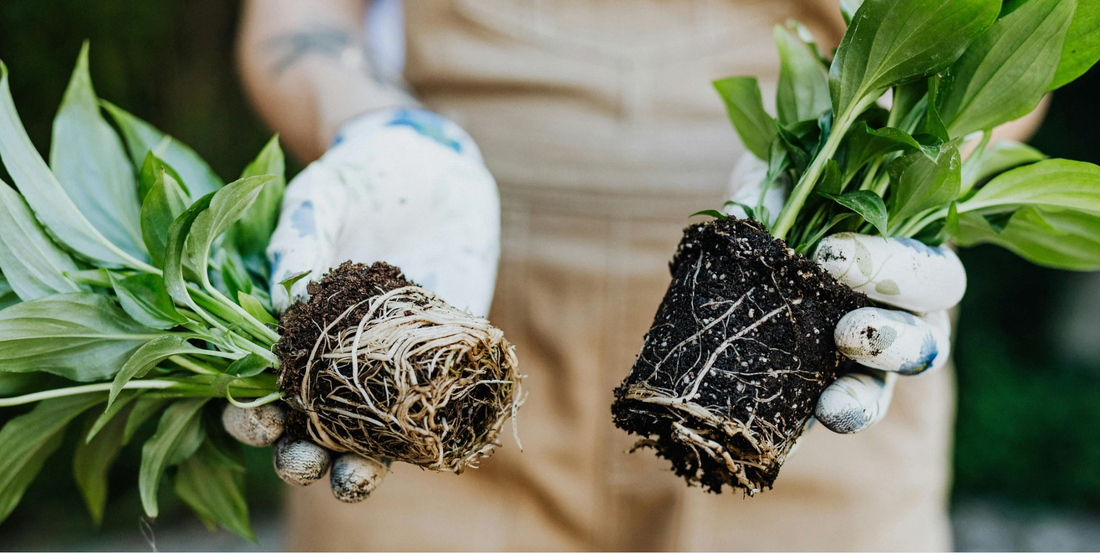The Science Behind Healthy Roots: Why Aeration Is Everything
Roots are the lifeline of your plants — the hidden network that determines how strong, lush, and resilient they’ll be. Yet, root health is one of the most misunderstood parts of plant care. While light and watering get most of the attention, what’s happening below the soil surface is where the real magic (and science) happens.
Why Roots Need Air as Much as Water
Healthy roots depend on oxygen just as much as they do on moisture. Every root cell requires oxygen for respiration— the process that powers growth and nutrient uptake. When soil is compacted or waterlogged, oxygen can’t move through the root zone, and roots begin to suffocate.
This lack of oxygen leads to anaerobic conditions, where harmful bacteria and fungi thrive — often resulting in root rot. On the other hand, well-aerated soil keeps roots breathing, supports beneficial microbes, and promotes strong, white, fast-growing roots.
The Science of Aeration: What’s Happening Underground
In nature, most tropical plants grow in airy, decomposing leaf litter or on trees as epiphytes — environments full of pockets of air. This balance of moisture and oxygen is essential.
When you use a dense or peat-heavy soil indoors, those air pockets disappear. Over time, roots can’t access the oxygen they need, and water sits stagnant around them.
To fix this, modern houseplant substrates use materials that increase porosity — the gaps in soil that let air and water move freely. The right mix keeps roots evenly moist but never smothered.
Common Aeration Components and What They Do:
-
Perlite: A lightweight volcanic glass that holds air and improves drainage.
-
Pumice: Heavier than perlite, great for long-term aeration and moisture balance.
-
Orchid Bark: Adds structure, encourages airflow, and mimics the natural forest floor.
-
Coconut Coir: Holds moisture while keeping the mix light and breathable.
-
Sphagnum Moss: Retains water without creating a dense, soggy environment.
Each of these materials serves a purpose in keeping the soil “alive” — not just in terms of air, but in creating space for beneficial microbes and worm castings to thrive.
Why All-Purpose Soil Isn’t the Right Choice for Houseplants
It’s tempting to grab a bag of all-purpose potting soil that says indoor and outdoor use and call it a day — after all, it says it’s good for “all plants,” right? Unfortunately, most of these mixes are designed for outdoor container gardening, not the controlled environments of indoor planters.
All-purpose soils are typically made with high amounts of peat or composted materials that hold too much moisture and compact quickly. Outdoors, this isn’t a big issue because air movement, temperature changes, and natural soil life help balance things out. Indoors, however, those same ingredients can suffocate your plants’ roots.
What Happens Below the Surface
When you use an all-purpose soil indoors:
-
Oxygen flow drops dramatically. Dense materials fill in the air spaces roots rely on to breathe. Without oxygen, roots can’t complete respiration, leading to slow decline and eventual rot.
-
Water lingers too long. Houseplants evolved in well-draining, aerated substrates. Dense soil traps water, creating soggy conditions that favor pathogens.
-
Microbial imbalance occurs. Beneficial microbes and fungi die off in compact, waterlogged soil, allowing harmful anaerobic bacteria to dominate.
-
Nutrient uptake decreases. Without oxygen and microbial activity, roots can’t absorb nutrients efficiently — even when you fertilize. The result is weak growth, yellowing leaves, and root rot.
Why Houseplants Need Specialized Mixes
Indoor plants — especially tropicals — are adapted to growing in naturally airy environments like forest floors, mossy tree crevices, and bark layers. Their roots expect high oxygen levels and consistent but light moisture movement, not the density of a garden soil.
That’s why using a houseplant-specific mix (like Maya or Molly’s blends) is essential. These mixes are designed to:
-
Provide steady airflow through ingredients like bark, perlite, and pumice.
-
Retain controlled moisture through coir and moss — enough hydration without saturation.
-
Support living soil ecosystems with worm castings and beneficial microbes that strengthen roots naturally.
When your soil mimics how roots grow in nature, plants develop stronger systems, recover faster from stress, and require less maintenance long-term.
The Microbiology of Root Health
A truly healthy root system isn’t just about structure — it’s about life. Healthy soils are teeming with beneficial microorganisms like mycorrhizal fungi and bacteria that form symbiotic relationships with roots.
-
Mycorrhizae attach to roots and extend their reach, helping plants absorb water and nutrients more efficiently.
-
Beneficial bacteria break down organic matter, turning it into plant-available nutrients.
-
Worm castings add enzymes and microbes while improving moisture regulation.
When your soil breathes, these microscopic organisms can flourish — creating a living ecosystem that feeds and protects your plants from the inside out.
Recognizing Healthy vs. Unhealthy Roots
Healthy Roots:
-
Firm and white to light tan in color
-
Evenly spread throughout the pot
-
Moist but not slimy
-
Smell earthy, not sour
Unhealthy Roots:
-
Brown or black, soft, or mushy
-
Weak, hollow, or foul-smelling
-
Surrounded by compacted, wet soil
If you notice black or mushy roots when repotting, trim the damaged sections and replant in a fresh, aerated mix to help your plant recover.
How Urbane Eight’s Soil Blends Support Root Health
Our Maya and Molly’s soil and substrate lines are formulated to keep oxygen flowing through the root zone while maintaining proper moisture balance. Each blend is peat-free, sustainable, and designed to support microbial life.
For a deep dive into our soils and what plants to use them for check out our blog about how to pick the right potting mix for my houseplants
-
Molly’s Aroid Mix – Bark- and perlite-rich for maximum airflow and drainage; ideal for philodendrons, monsteras, and tropical plants.
-
Maya Aroid Mix – Premium, structured blend with pumice and coir for aeration and moisture control.
-
Maya Bonsai Blend – Encourages fine, dense root systems through controlled moisture and texture.
-
Maya General Mix – A balanced option for most houseplants, providing long-term soil structure and nutrient flow.
Every mix is designed to prevent suffocation, encourage healthy root expansion, and sustain the living ecosystem that supports plant resilience and growth.
Rooting Gels and Soil Biology: A Perfect Match
For propagation or reviving stressed plants, Evolve i-Rooting Gels #1, #2, and #3 offer precise hormone support while your soil blend maintains oxygen flow. The gel stimulates root initiation, while breathable substrates allow new roots to grow strong instead of rotting.
Together, these products replicate the plant’s natural rooting environment — oxygen-rich, biologically active, and free from suffocating buildup.
Key Takeaways
-
Roots need oxygen as much as water — poor aeration is a leading cause of root rot.
-
All-purpose soils are too dense for houseplants and can suffocate roots indoors.
-
Healthy soil structure allows both air and water to move freely.
-
Beneficial microbes and worm castings are essential for long-term root health.
-
Using aerated, peat-free mixes and targeted rooting gels helps plants grow stronger and live longer.
When you care for what’s happening beneath the soil, the results always show above it — healthier leaves, stronger stems, and thriving plants year-round.




